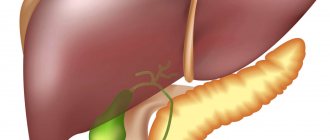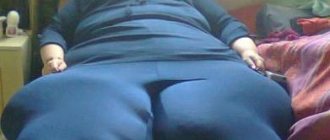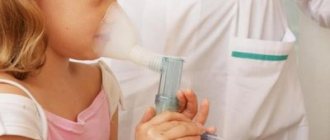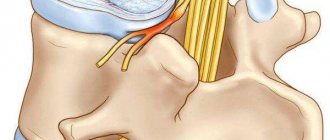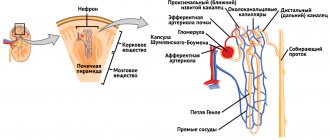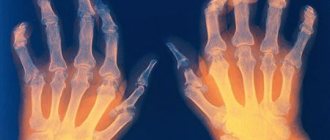In this article we will look at the causes and treatment of kyphosis of the thoracic spine and the features of this disease. The human spine performs many functions and its main task is to reduce the load that is placed on the back and the entire posture of a person.
A healthy spine has two curves at the back and front (this improves shock absorption when walking and running). When the deformity occurs in the back of the back, doctors diagnose kyphosis. It happens that the disease occurs in the thoracic region.
Kyphosis of the thoracic spine
A healthy human spine has 4 curves that reduce the load on certain parts of it. The thoracic and sacral sections are curved inward - this is the natural position of the spine, however, due to some external factors, its curvature occurs (usually in the upper back).
Speaking about such a disease as kyphosis, it can be said that most often it occurs in the thoracic region . Pathology of the lumbar region, sacral and positional kyphosis are less common and are accompanied by symptoms of a different kind.
Kyphosis is a curvature of the spine that exceeds the permissible level of curvature. In children by the age of 7, physiological kyphosis of the thoracic spine is formed. An acceptable angle of inclination is no more than 30 degrees. Kyphosis develops gradually and its manifestations are noticeable visually.
What thoracic spinal kyphosis is is quite simple to understand - it is a disease of the musculoskeletal system, which is not only visually pronounced, but also causes the patient a lot of inconvenience, discomfort and pain. This pathology causes rapid aging of the vertebral bodies, intervertebral discs and contributes to the development of osteochondrosis.
Many diseases that are associated with impaired functioning of internal organs can contribute to the development of the disease. The cause of this disease is a weakening of the spine in some area, as a result of which increased stress is placed on it and it bends more strongly. In addition, a number of factors can also lead to pathology:
- heredity;
- injuries;
- poor posture.
In addition to kyphosis, there are many other diseases of the spinal column. The most common ones include scoliosis, lordosis (cervical, lumbar), etc. We will consider what the main differences between these pathologies are below.
Pathological kyphosis
Only those influences that occur during the period of intensive growth of the musculoskeletal system can enhance the normal curvature of the spinal column in the chest area. Therefore, pathological changes always develop only in a child’s body, although they can already appear in adolescents or adults:
- Most often, the disease is based on incorrect or defective formation of the ligamentous and muscular apparatus.
- It can be congenital - associated with initial defects in the maturation of connective tissue.
- Acquired kyphosis of the thoracic spine is a consequence of insufficient physical development or improper exercise regimen.
- The primary factor may also be a violation of the ossification of the vertebrae, which makes them unable to withstand increasing loads. Their gradual deformation is observed - flattening in the anterior sections, which experience maximum pressure.
- In most cases, these factors sooner or later combine, which leads to severe combined damage to the spine.
It is important to catch the disease precisely at the stage of damage to only soft tissues - if kyphosis is increased due to deformation of the vertebrae, then conservative measures will not be effective.
Manifestations
Before moving on to describing the symptoms of the disease, it is necessary to consider the signs of functional kyphosis. This condition is considered borderline between normal and pathological, being a sign of weakness of the muscular corset surrounding the spine. It is characterized by the following features:
- In the standing position, the thoracic curve is strengthened only slightly - its relative rounding is noted in relation to the lumbar and cervical lordosis.
- Additionally, such a patient has a stooped posture - it is created as a result of an accentuated transition to kyphosis in the lower segment of the neck.
- The position of the shoulder girdle and upper limb is not changed - the shoulder blades do not protrude much and are located parallel to the back. When viewed from the side, the shoulders are straightened, the arms are along the body along the midline.
- Kyphosis intensifies only with special functional tests. The first involves sitting relaxed on a chair or stool, which causes the bend to increase. The second test is the starting position for push-ups from the floor (lying position), which also emphasizes pronounced kyphosis.
- The patient can calmly stand with his back to the wall, simultaneously touching it with 4 points - the back of the head, shoulder blades, buttocks and heels.
If most signs of a functional nature are present, then increased kyphosis requires only preventive measures for correction.
Congenital
There are two main options for the development of events associated with spinal malformations. The time of manifestation of the disease depends on this - in early childhood or adolescence. The first case includes all vertebral dysplasia that gives symptoms already by the first year of life:
- Kyphosis of the thoracic spine begins to intensify in parallel with the increase in the child’s activity.
- There is a slowdown in the rate of physical development - the baby later begins to hold his head, crawl, sit and learn to walk.
- A gradual transition to a vertical position is accompanied by increased curvature. Often children can only sit, as the deformed spine does not allow them to maintain balance when walking.
- Without timely surgical treatment, chest deformities gradually develop, leading to irreversible changes in the respiratory system and heart.
The second variant of pathology is Scheuermann-Mau disease. It is caused by disturbances in the ossification processes of the thoracic vertebrae, leading to a decrease in their strength:
- The debut of pathology is always observed in adolescence, when the maximum growth spurt of the body occurs.
- There is a gradual increase in kyphosis, accompanied by a persistent change in posture.
- There are episodes of back pain, discomfort in the interscapular area, and difficulty breathing.
- Unlike functional curvature, the position of the spine does not change either at rest or during special tests.
Congenital pathologies are confirmed using X-ray methods that reveal characteristic changes in the shape of the lower thoracic vertebrae.
Acquired
This group of manifestations is characterized by the appearance of symptoms provided that the spine is initially healthy. Then some pathological process led to damage to the bone or connective structures, as a result of which the thoracic curve became sharply increased:
- If the cause of the increase in curvature is an injury—a vertebral fracture—then its manifestations are additionally noted. It is always preceded by a fall or blow to the spine. Additionally, there is sharp pain in the area of the fracture and a sharp limitation of mobility.
- Increased bending due to rickets is observed only in children - due to a lack of vitamin D, the development of the musculoskeletal system is disrupted. In addition to damage to the spine, deformations of the skull, as well as large joints, are noted.
- Osteoporosis in older people often causes the development of pathological kyphosis. It is caused by a compression fracture of the lower thoracic vertebral bodies. This process can be asymptomatic, determined only by an in-depth examination.
- Pathological fracture of a vertebra due to tuberculosis or tumor metastases is also a common occurrence. Diagnosis is also difficult, since in addition to increased kyphosis, it is difficult to identify other signs.
All of these cases are united by one phenomenon - kyphosis, therefore, during the examination, much attention is paid to additional differential signs.
Lordosis and kyphosis
Lordosis and kyphosis are diseases of the spinal column in which an outward bulge of the ridge is formed. These diseases do not exist as independent pathologies, as they are the result of some pathological processes.
For example, pathological and osteochondropathy kyphosis are the result of ankylosing spondylitis. Scoliosis is a disease characterized by deformation to the side and develops more often in childhood. Pathology can occur in different parts of the spine. According to their origin, scoliosis is usually classified into:
- congenital;
- paralytic;
- traumatic;
- dysplastic.
For many, it remains unclear how kyphosis differs from scoliosis. In both cases, we are talking about curvature of the ridge, however, with kyphosis, the curvature of the spine occurs in the thoracic region and has a convex appearance (stooping). Scoliosis is characterized by asymmetry of the body, curvature occurs to the sides (to the right or left).
In rare cases, scoliosis and kyphosis occur simultaneously. In this case, the spine curves in two planes at once: S-shaped to the side and C-shaped outward.
Pathological kyphosis is divided into acquired and congenital. The pathology develops gradually and has 4 degrees of severity, each of which characterizes the angle of curvature of the spinal column. The first stage is characterized by a bend of up to 40 degrees, the second – up to 50, the third – up to 60, the last, fourth stage, is considered the most difficult, since the bend of the spine can reach 70 degrees.
Physiological kyphosis develops by the age of 6-7 years, but the angle of curvature of the spine should not exceed 30 degrees. Every person has this type of kyphosis and is a completely normal physiological phenomenon. Deviations are indicated by a bending angle that exceeds 45 degrees. Pathology can occur due to poor posture. The disease is most often diagnosed in men under 30 years of age. The main cause of this problem is a sedentary lifestyle and low physical activity.
Also, it is considered pathological when thoracic kyphosis is strengthened and smoothed; let’s take a closer look at what this means. As mentioned earlier, the acceptable angle of curvature of the spine is considered to be 15-30 degrees. However, if the indicator is less than 15, this already indicates a smoothed form of kyphosis.
This deviation most often occurs in people who spend most of their time in a lying position. The smoothed form of kyphosis is characterized by a number of symptoms:
- poor health in general;
- headache, back pain;
- frequent urination;
- the presence of intervertebral hernias;
- disturbances in the gastrointestinal tract.
If the angle of deformation of the ridge exceeds 30 degrees, we can talk about the development of increased kyphosis. This form of kyphosis can be grade 1, 2 and 3.
How to treat scoliosis in children?
Kinds
Kyphosis manifests itself in different ways - from a barely noticeable stoop to a pronounced hump. Curvatures can be observed in various parts of the thoracic region - cervicothoracic, upper thoracic, thoracolumbar.
By form:
- Angular kyphosis (kyphosis angularis), or hump. Characterized by an angular convexity of the back, with the apex backwards.
- Arc-shaped kyphosis. It is characterized by a convexity of the back in the form of a short or long arc.
- Physiological kyphosis (kyphosis physiologica). Typically a stage of spinal development. It is characterized by a slight tilt of the spine - up to 30 degrees. It can be present in the thoracic region up to 7 years, in the lumbar region (sacrum) - until puberty.
Functional thoracic kyphosis
This type of pathology is also called common stoop. Most often it occurs due to weak back muscles, constant stooping, excessive physical exertion, and improper body position while working at a desk. If you place such a patient on a flat surface, the bend will disappear on its own.
When performing fluoroscopy, no changes in the vertebrae will be noted in the images. To treat this type of disease, conservative treatment, primarily aimed at strengthening the muscles, is sufficient.
Dorsal juvenile kyphosis (Scheuermann-Mau disease)
Scheuermann-Mau disease - develops in adolescence mainly in boys, and is expressed in the formation of wedge-shaped vertebrae in the lower thoracic or upper lumbar spine and changes in the ligamentous apparatus
Congenital kyphosis
This is a defect in the development of the vertebral bodies (anterior sections) caused by a genetic mutation and inherited.
Paralytic kyphosis
Paralytic kyphosis is caused by diseases accompanied by paresis and paralysis of the back muscles (cerebral palsy, poliomyelitis, etc.). With cerebral palsy, there is an increase in thoracic kyphosis and an increase in its length (the curve extends to the upper part of the lumbar region). Kyphosis can be combined with scoliosis. Characteristic is a gradual progression of the deformity. Treatment is usually conservative, complex, and long-term.
Rachitic
Develops in children with rickets starting from the sixth month of life. However, rachitic kyphosis often develops in older children or adolescents who suffered from rickets in early childhood.
Post-traumatic kyphosis
The cause of the development of the disease is previous injury to the spine. The progression of the disease further causes compression of the nerve structures in the spinal column. When the spine is fractured in the thoracic or lumbar region, kyphosis of one degree or another develops; based on the severity of the injury, the appropriate treatment is determined, which, in turn, can be either conservative or surgical.
Postoperative
It develops infrequently after operations on the spinal column due to trauma, anterior displacement of the vertebra due to congenital non-fusion of the vertebral arch with its body (spondylolisthesis), replacement of the intervertebral disc, and others.
Senile (degenerative) kyphosis
This type of curvature is caused by degenerative changes in the vertebral bodies and intervertebral discs, which are accompanied by the so-called “subsidence of the spine”, as well as weakening of its ligamentous apparatus
Causes of kyphosis
There are many causes of the disease. In medicine, it is customary to classify kyphosis into acquired and congenital. For each type, there are factors that cause the development of this pathology.
Congenital kyphosis can appear in utero, as a result of various developmental abnormalities, or be the result of poor heredity. Also, during difficult childbirth, injury to the musculoskeletal system may occur, which will lead to this disease.
The pathology most often occurs in children (usually boys). Kyphosis is less common in adults, but it can also occur (especially in women over 50 years of age).
Despite the classification of the disease, doctors identify a number of main reasons that can provoke kyphosis:
- Staying in an incorrect position for a long time. This may be related to the field of activity; it often occurs in people with sedentary professions.
- Previous injuries, spinal surgeries.
- Advanced form of osteochondrosis.
- Concomitant diseases or their consequences (rickets, tuberculosis, lordosis, cerebral palsy, etc.).
- Age factor.
- Overweight.
- Sedentary lifestyle.
Causes
Kyphosis can occur in both children and adults, as well as the elderly. And in each case, different reasons lead to it, therefore, depending on them, several main types of kyphosis are distinguished.
Statistics indicate that up to 10% of people around the world live with some degree of kyphosis. Male children and adolescents are more susceptible to it.
There are many reasons that can cause kyphosis. Acquired curvature of the thoracic spine can result from:
- Operations performed on the spinal column or accompanied by opening of the chest.
- Spinal injuries, especially with vertebral fractures.
- Degenerative changes, most often osteochondrosis and intervertebral disc herniation, as well as spondylosis.
- Age-related disorders occurring in the vertebrae and intervertebral discs.
- Partial paralysis of the back muscles, weak muscle corset.
- Pathological changes in the ligamentous apparatus.
- Poor posture, passive lifestyle.
- Rickets suffered in infancy.
- Tuberculosis of bones.
Taking into account the angle of curvature, normal, increased (with an increased angle) and straightened (with a reduced angle) kyphosis are distinguished.
Thoracic kyphosis is most widespread. It can be considered pathological if the curvature exceeds 31 degrees. Depending on the severity of the bend, there are 4 degrees of thoracic kyphosis:
| 1st degree |
|
| 2nd |
|
| 3rd |
|
| 4th degree |
|
True kyphosis should be distinguished from kyphotic posture associated with muscle weakness. With it, lying on your stomach on a hard surface, your back is leveled.
Kyphosis may also differ in the progression of the deforming process. Thus, when the inclination increases to 7 degrees per year, they speak of a slowly progressive form of kyphosis. Accordingly, with rapidly progressing kyphosis, the pathological change in the angle of inclination ranges from 7 degrees or more per year.
Symptoms of the disease
Kyphosis has several stages of development, each of which has its own characteristics. It is very important to pay attention to them in a timely manner and take measures to eliminate them.
At the beginning, the disease practically does not manifest itself, the patient does not feel pain or discomfort. Kyphosis is often preceded by scoliosis, which occurs in the thoracic region. A person feels tired in his back muscles, and by the evening he has an urgent need to lie down. This is how the 2nd degree of severity of the pathology develops. During this, the curvature of the spine becomes more clear, and the following symptoms begin to appear:
- pain is felt in the thoracic region;
- There is numbness in the upper extremities;
- the muscles of the shoulders and forearm weaken.
At stages 3 and 4, the curvature of the spinal column becomes pronounced. A person with kyphosis has a pronounced stoop, with his shoulders and stomach protruding forward and his chest falling inward.
Kyphosis at the last stage affects the functioning of the spinal cord, nerve endings and the entire body as a whole. The following deviations may be observed:
- Lordosis may begin to develop in the lumbar and cervical region.
- Chronic pathologies of internal organs develop.
- Problems with the cardiovascular system arise, and ventilation of the lungs worsens.
- Pressure is exerted on all internal organs of the gastrointestinal tract.
- The strength of joints and ligaments decreases.
- Blood supply to the brain deteriorates.
Kyphosis is a disease that not only causes aesthetic problems, but also causes a number of serious complications. Due to the modification of the spine in the thoracic region, the lungs and their functioning are affected. Reducing the thoracic space affects the functioning of the cardiovascular system and gastrointestinal tract.
Often this disease occurs in young children or adolescents. This is usually due to a slowdown in the growth process and development of the spine. Symptoms of spinal kyphosis in children are not difficult to identify. The child begins to develop the so-called “round back” syndrome, with aching, nagging pain and severe fatigue. As the disease progresses, there is a decrease in sensitivity in the lower extremities.
Pay attention to the photo of juvenile kyphosis:
Surgery
When kyphosis is accompanied by irreversible deformation of the vertebrae themselves, it can only be eliminated through surgery. Typically, the following interventions are used to correct pathological changes:
- Functional methods involve partial or complete restoration of mobility in the affected segment of the spine. Currently, various options for vertebral prosthetics are used for this, as well as their fixation using metal structures.
- Cosmetic methods are carried out only for acquired options that are not accompanied by a pronounced loss of mobility. Various options for resection of the affected areas are carried out with their subsequent fixation using spinal fusion (joint closure) or a prosthesis.
The operation does not imply an immediate return to normal position, as well as all functions of the spine. Therefore, after the intervention, the patient goes through all stages of conservative treatment, which allows the muscles and ligaments to adapt to the changes.
It can be useful:
- Anatomy of the human wrist joint
- Structure of the temporomandibular joint
- The structure of human ribs
- Human chest bones
- Nerves of the human spinal cord
How to diagnose the disease
Despite the seriousness and complexity of the pathology, diagnosing it is quite simple. Often a visual examination is enough for a doctor to diagnose the disease. In advanced stages, the patient cannot bend over and reach his feet.
To identify the stage of the disease and the characteristics of its course, a specialist can refer to the following diagnostic methods:
- radiography;
- MRI.
The pathology is treated by an orthopedic surgeon. The specialist may refer you for additional consultation to a neurologist and therapist.
Concept of kyphosis
Kyphosis is a disease associated with curvature of the spine at the chest level. Leads to stress on the musculoskeletal system, in especially severe cases it causes rupture of the spinal nerves, which can lead to paralysis.
In medicine, this disease has been known as a disease for a long time. Even ancient Greek doctors identified cases of spinal curvature in people and forced them to wear straightening corsets for a long time.
Today, medicine has advanced far and the degrees of complications of the disease vary. An individual treatment approach has been developed for each degree. Thanks to the internal interaction of doctors of various specialties, complications and damage to related human organs are prevented in a timely manner.
For a more detailed description of the treatment method for this disease, it is necessary to determine the differences in complication levels.
Treatment of the disease
Therapeutic measures to eliminate the disease begin with a visit to the doctor and undergoing a full examination. Based on its results, the specialist will prescribe individual treatment.
As a rule, treatment of kyphosis involves complex therapy, which includes:
- manual therapy;
- gymnastics and exercise therapy;
- physiotherapeutic measures, wearing corsets;
- surgical intervention;
- visiting specialized sanatoriums.
At home
How to cure and correct kyphosis at home in adults is a fairly pressing question among patients suffering from this problem. However, you should immediately pay attention that independent treatment may not give the expected results , since it involves performing special exercises, wearing a corset and massage courses.
Is it possible to correct the angle of kyphosis at 30 years old at home? This is a difficult question. However, using all methods of therapy and adhering to all the doctor’s recommendations, the progression of the disease can be stopped and the angle of curvature can be corrected.
At an early stage of the disease, wearing corsets is effective. Such corsets, together with massages and exercise therapy, can correct posture and prevent further progression of the pathology. They are therapeutic and preventive.
How to do massage for scoliosis?
Exercise therapy
Physical therapy exercises can strengthen the muscular corset of the back, correct posture, and normalize blood circulation. Such exercises should be performed daily.
You should devote at least an hour a day to physical therapy, the load should be added gradually, the exercises should be performed without sudden movements, and there should be no pain. Exercises for kyphosis of the thoracic spine can only be prescribed by a specialist.
Massage and manual therapy
Massage courses are prescribed as an auxiliary treatment. Before starting a massage, it is important to prepare the muscles, relax and warm them up. The curvature area is massaged very carefully. The affected area can be rubbed and kneaded.
If the patient does not experience pain, treatment can be carried out with manual therapy. This treatment method is based on a special technique that involves forceful pressure on certain segments of the spine. With this pathology, courses of manual therapy must be carried out every 3-4 days.
Diagnostics
Diagnosis of kyphosis of the thoracic spine is the responsibility of an orthopedic doctor.
- First, the patient is interviewed, after which the doctor examines him. It is important to clarify the characteristics of pain, their localization, and the presence of neurological disorders.
- During the examination, the orthopedist palpates the neck and back, checks muscle strength and skin sensitivity.
- In addition, the doctor listens to the heart rhythm and lungs, and evaluates tendon reflexes using a specialized set of tests.
Not only the main manifestations of the disease, but also the treatment tactics for the pathological condition depend on the degree of kyphotic curvature. Therefore, before treating kyphosis of the thoracic spine, the doctor will necessarily refer the patient for an X-ray examination of the spinal column, computed tomography or MRI.
Additional instrumental studies are necessary to determine the degree of kyphosis and identify associated pathologies. These include:
- X-ray of the affected part of the spine in two projections. The doctor determines the degree of kyphotic deformity on a lateral radiograph by calculating the angle of inclination of the spine;
- MRI, CT – are indicated for more detailed diagnostics; they visualize the bone structure of the vertebrae, intervertebral discs, and ligaments;
- angiography (vascular examination) – relevant for cervical kyphosis.
How to independently identify thoracic kyphosis?
There are several tests you can do to diagnose thoracic kyphosis yourself and to seek treatment.
- Stand with your back to the wall and lean on it, try to reach the back of your head to the surface without moving your head back. If you have a disease, this will be difficult to accomplish.
- Bend forward towards the floor and look at your curve in the mirror. If there is deformation, the ridge will not fully straighten.
Prevention of kyphosis
You can prevent problems with the spine by following a number of preventive measures:
- regularly monitor your posture;
- It is recommended to sleep only on a hard surface;
- it is necessary to lead an active lifestyle, play sports (swimming is very effective for back health);
- when working sedentarily, it is important to maintain posture and choose the right chair;
- Avoid frequent carrying of heavy objects;
- It is important to monitor your diet; it should be rich in vitamins and microelements.
Symptoms and signs of the disease
At the initial stage of development of pathological kyphosis, symptoms are limited to minor changes in figure and posture: the patient is slouched, his back is round, and his head is slightly tilted forward. A person can still keep his back straight when he controls himself, but this causes him pain.
The progression of the curvature leads to the fact that the patient is unable to keep his back straight. The stoop worsens until a noticeable hump appears on the back.
The shoulders of a person suffering from kyphosis seem to be drawn towards each other and downwards. As a result, the chest narrows, which disrupts the functioning of the lungs and heart, and the diaphragm, lowering, puts pressure on the internal organs of the abdominal cavity. All this ultimately leads to a whole “bouquet” of various health problems:
- the functions of many vital internal organs are disrupted;
- vertebral structures are deformed - vertebrae and intervertebral discs, which leads to the formation of protrusions, hernias, pinching of the spinal nerve roots with all the ensuing consequences, including loss of sensitivity in the limbs;
- the muscular frame weakens due to pathological redistribution of the load on the muscles;
- the hip and knee joints experience excessive stress and become prematurely deformed and destroyed;
- blood circulation in the chest and abdominal cavity is disrupted, which inevitably leads to persistent vascular changes in the brain;
- the patient constantly experiences pain in the back and other parts of the body and organs affected by the consequences of severe kyphosis.
Treatment of kyphosis
Basically, therapy for degrees of kyphosis remains conservative. The following procedures are encouraged:
- Therapeutic physical education or exercise therapy. Strengthens the back muscles.
- Special massage.
- Physiotherapy.
- Manual treatment.
- Corsets. Help reduce pain. They are worn periodically because they do not have a therapeutic effect. Moreover, regular use of a corset leads to even greater muscle weakness and progression of kyphosis.
Surgery is not necessary in the initial stages of the disease. However, there are situations in which surgery cannot be avoided:
- Chronic severe pain that does not disappear during conservative therapy;
- Rapid curvature of the spinal arch, severe neurological abnormalities, pathologies of the heart and lungs;
- Cosmetic defects that cause complexes and interfere with an active lifestyle.
Surgical intervention is aimed at normalizing the angle of curvature of the spinal arch as much as possible and preventing the subsequent development of the disease. It is also important to restore the functioning of the nerve roots.
Unfortunately, the operation is complex; it cannot be performed without general anesthesia and requires a preliminary full examination of the patient. Sometimes the patient needs multiple surgical interventions.
To prevent curvature, the spine is fixed with special structures made of inert metal (titanium, for example).
Diagnostic methods
The main method for diagnosing pathological changes in the spine is radiography. Next, the lateral image is placed on a X-ray viewer and the centers of the vertebra located at the top of the bend and the vertebrae at the edges of the bend are marked with a dot. The points are joined together by a triangle, after which its sides are extended. The resulting angle is a determining indicator of the extent of the lesion.
The second diagnostic technique is computer or magnetic resonance imaging. The method is characterized by extremely high information content, allows you to create a three-dimensional model of the spine, determine the presence of deep changes, and accurately localize the affected area. It is used primarily in preparation for surgery or in cases where kyphosis is caused by internal pathological processes. In other situations, MRI is not economically feasible.
Other diagnostic methods are of auxiliary value and are prescribed mainly in the presence of secondary diseases. The patient may need an ECG, ultrasound of the abdominal organs, spirometry, chest x-ray, gastroscopy, and high-tech examination methods (radioisotope diagnostics). During hospitalization, a standard set of laboratory tests is prescribed:
- general blood analysis;
- general urine analysis;
- blood chemistry;
- HIV, hepatitis, syphilis;
- coagulogram;
- acid alkaline electrolytes.
The study of biological environments allows us to identify signs of internal disorders, as well as ensure the infectious safety of employees of a medical institution.
Treatment of congenital pathological changes of grade 3 and 4 is carried out surgically. Conservative methods are ineffective. During the operation, the spine is given the required shape and fixed with surface metal plates. Subsequently, the installed structures are dismantled. This requires another intervention. Surgeries on the spinal column are very risky, dangerous and do not guarantee recovery. Often the doctor can only reduce the degree of changes, but not achieve a completely correct form.
Acquired kyphosis of the 1st degree is easily treatable. In most cases, the patient is prescribed to wear a corset that maintains the correct shape of the back. The support time is increased gradually. In the first days it lasts 30-40 minutes, by the end of the course the person wears a support device for several hours a day. Continuous wearing of a corset is not allowed.
Kyphosis of the thoracic spine of the 2nd degree requires a wider range of measures. In addition to the corset, the patient is prescribed therapeutic exercises. The exercises are aimed at strengthening the paravertebral muscular frame, straightening the back, and developing correct posture. The best complex is considered to be using a gymnastic stick. A good effect is achieved when exercising on the horizontal bar.
For deep lesions, a corset is not used. The patient is prescribed moderate, in accordance with physical capabilities, physical activity, massage, and a gradual increase in activity. Symptomatic therapy is used in accordance with existing secondary diseases. In reality, all conservative measures practically do not bring any lasting effect. The only method for correcting stage 3 and 4 pathological kyphosis is surgery (osteotomy followed by osteoplasty).
When treating 1st degree curvature, the following methods are used:
- Physiotherapy.
- Physiotherapeutic methods.
- Moderate physical activity, avoiding excessive exercise.
- Proper nutrition.
- Use of orthopedic devices.
- Posture correction.
A corset for kyphosis will help correct minor curvature
READ MORE: Spinal diseases and their diagnosis
To correct the deformity, special corsets are used. They relieve the spine and keep it in the correct position. You need to choose a device that is exactly the right size. However, it is not recommended to wear a corset all the time, otherwise the muscles around the affected area weaken, and then it is difficult for them to support the spine. The optimal wearing time is 20 hours per day, but gradually this time needs to be reduced.
Exercise therapy will help strengthen the muscular corset, as well as the muscles of the upper back, and correct curvature at an early stage. In addition, gymnastics improves metabolic processes and stimulates blood flow. It is recommended to train daily for 30–40 minutes. Only with regular exercise will you be able to achieve positive dynamics. The exercise program is drawn up by the doctor for each patient separately.
Complex treatment can be supplemented with massage and manual therapy. The main thing is to find a qualified specialist. These procedures are effective in the early stages of the disease; they will help correct posture, restore muscle tone, realign displaced vertebrae and discs between them, and normalize blood flow.
The patient must also follow a diet. It is important to replenish your diet with food rich in proteins, complex carbohydrates, fiber, vegetable fats, vitamins, and minerals. Proper nutrition will help improve metabolic processes and the general condition of the body, saturate it with useful substances.
In the early stages of the disease, physiotherapeutic procedures are used:
- Magnetotherapy.
- Ultrasound treatment.
- Electrophoresis.
- Heat therapy.
- Electrical stimulation.
- Mud therapy, etc.
For grade 2 kyphotic curvature, the following drugs are used:
- To relieve pain, use Diclofenac, Segan, Analgin, Baralgin, etc.
- To restore cartilage tissue between the vertebrae, chondroprotectors are used, for example, Chondroflex, Chondroitin, Teraflex.
- To strengthen the body, the patient is prescribed medications based on B vitamins, as well as mineral and multivitamin complexes.
Surgical treatment in the early stages of pathology is extremely rare. Doctors make the decision to perform an operation if conservative treatment methods are ineffective, there is severe pain that cannot be controlled with medications, and there are serious disorders in the functionality of internal organs.
The pathology rarely reaches an advanced stage, but if this happens, then conservative methods will be ineffective. Massage, physiotherapeutic procedures, and medications will only help reduce symptoms and slightly improve the patient’s condition.
To relieve inflammation and relieve pain, NSAIDs are used, for example, Diclofenac, Nise, Ibuprofen. Ketanol, Ketoral, Baralgin, etc. also help reduce pain.
Treatment of grade 3–4 kyphosis is carried out surgically. The operation will help reduce curvature, release nerve bundles from compression, and eliminate pain.
For grade 3–4 spinal deformity, only surgery will help.
For kyphosis, the following operations are performed:
- Osteotomy. During a surgical procedure, the doctor removes sections of the affected vertebrae or the entire body of the vertebrae. The spine is fixed using implants, special plates or screws. The cracks are filled with donor material, but there is a risk that the body will reject them.
- Spinal fusion. During the operation, the spinal column is straightened, and its structural elements are fused using special plates or rods. These structures will help fix the spine in the desired position.
- Kyphoplasty. This operation is prescribed for curvature of the spine after injury or compression fracture, but no later than 8 weeks after spinal injury. The procedure is performed under local anesthesia through a small incision under X-ray control. A container containing a contrast solution is injected into the area of the damaged vertebra. This manipulation helps to accurately determine the location of the damage. Inside, the balloon inflates, restoring the destroyed element of the spine. Then the contrast liquid is pumped out, the canister is removed, and the cavity it formed is filled with a quickly hardening cementitious solution.
Kyphoplasty is a safe and low-traumatic operation, during which the likelihood of damage to the spinal cord is minimal. In addition, the patient recovers quickly after the procedure. However, this method of surgical therapy is not used for rapidly progressing kyphosis, a pathology that arises as a result of poor posture, infectious diseases or congenital diseases.
Reference. Surgery will not completely get rid of the problem. The operation will help eliminate the severe symptoms of severe curvature, but the patient will not be able to return to a full life. He will have to give up heavy physical activity forever.
After surgery, the patient must perform exercise therapy, take medications, NSAIDs, adjust nutrition, and take vitamins. It is important to strictly follow your doctor’s recommendations to avoid further progression of the disease.
If kyphosis is suspected, the patient is referred to an orthopedist. The specialist first studies the patient’s chart, after which he conducts an examination, during which he determines abnormalities in the body by touch. A more accurate diagnosis is determined using bone x-rays and magnetic resonance imaging to determine changes in soft tissues. In addition, they may refer you to a CT scan.
Treatment for kyphosis includes massage and physical therapy aimed at strengthening muscles and aligning bones. Therapy is prescribed, in which the doctor uses his hands on the spine, and also prescribes wearing a corset. The latter is prohibited from being used constantly, as it can weaken the back muscles, which will worsen the situation.
Below is a video with exercises to correct and prevent kyphosis.
Another way to return the patient to a full life is through surgery.
https://www.youtube.com/watch?v=gXID0N6Czl4
It is used under the following circumstances:
- A person experiences severe, frequent pain that cannot be relieved by medication.
- The disease develops quickly, disrupting the functioning of other organs.
- Significant deterioration in the comfort of human life.
The main goal of surgeons is to set the bones in the correct position and secure them to prevent damage to vital organs. The operations are performed under general anesthesia, often more than once. After it is carried out, titanium or nickel frames are implanted into the spinal column, which are not alienated by the body.
Prevention
Prevention of kyphotic curvature of the spine can only be discussed in non-congenital forms of kyphosis, as well as forms that are not accompanied by structural changes in the vertebrae or their anomalies. For example, it is impossible to prevent Scheuermann's kyphosis.
For Scheuermann's disease, the best prevention is early diagnosis. If you detect structural kyphosis in the early stages and follow your doctor's recommendations, you can try to minimize the progression of kyphosis.
In cases of non-structural kyphosis, prevention includes:
- daily general strengthening gymnastics, physical exercises that strengthen muscles and stretch the spine into its natural position;
- constant work on posture: you need to literally monitor the position of your back every minute;
- night rest on hard and hard beds;
- in case of a spinal fracture or bone disease, as well as for older people, it is necessary to take vitamin and mineral complexes, a balanced diet, and eat foods rich in calcium.
Symptoms
Let's look at the symptoms of kyphosis of the thoracic spine.
Deformation of the thoracic back: the appearance of a hump or severe curvature of the spine in the chest area. This symptom is noticeable from the outside. If there is a hint of excessive bending, prevention of kyphosis is obvious and mandatory.
Without comprehensive work with your back, this curve will only increase with age and turn into a hump in old age. Back deformation is accompanied by other visible changes in body constitution:
- shoulders tend to slope down and protrude forward;
- the area of the chest decreases;
- the shoulder blades protrude, forming an acute angle with the back;
- the growth of the abdomen is visually noticeable as a result of compression from the chest; flat feet.
Among the symptoms that are invisible to the eye are:
- omission of the diaphragm;
- pressure on the lungs and abdominal organs;
- pinching and pinching of nerve endings;
- back pain.

